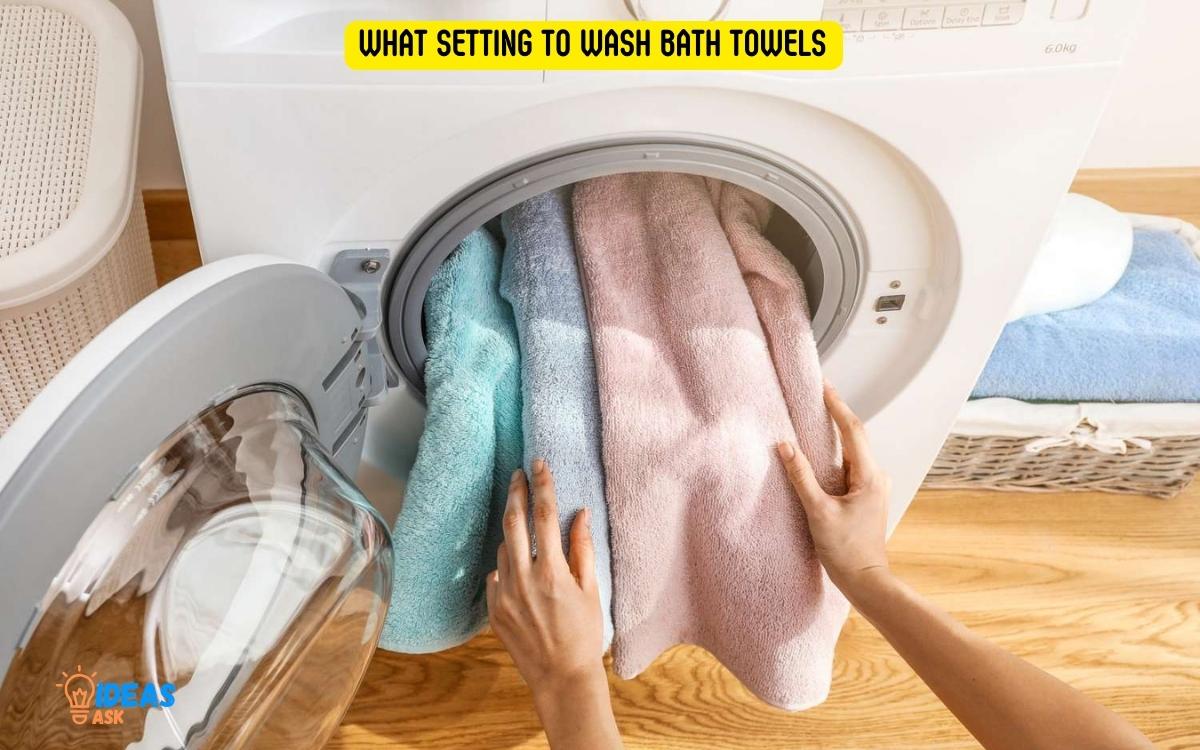What Setting to Wash Bath Towels? Discover Tips & Advice!
The best setting to wash bath towels is on a warm wash cycle (around 40°C-60°C) using heavy-duty detergent.
It is also recommended to use high spin speed to remove as much water as possible before drying.
Bath towels often accumulate body oils, bacteria, and other residues. Washing them on a warm cycle helps to properly clean and disinfect them.
Always check the towel’s care label before washing as some materials may have specific washing instructions.
Avoid using fabric softener as it can reduce the towel’s absorbency. To keep towels fresh and fluffy, occasionally run them through a rinse cycle with white vinegar instead of detergent.

Key Takeaway
Understanding The Fabric Requirements
Understanding the fabric requirements for washing bath towels is essential to maintain their quality and longevity.
It is recommended to wash them in warm water with a gentle detergent to prevent damage and preserve their softness.
Different Fabric Types For Bath Towels:
- Cotton: One of the most common fabric types for bath towels, cotton is known for its softness and absorbency. It is breathable and gentle on the skin, making it ideal for everyday use.
- Egyptian Cotton: Considered the crème de la crème of cotton, Egyptian cotton towels are known for their durability and luxurious feel. The long fibers make them highly absorbent, ensuring they dry quickly between uses.
- Microfiber: Made from synthetic materials such as polyester and nylon, microfiber towels are lightweight and quick-drying. They are highly absorbent and resistant to mold and mildew, making them a popular choice for gym-goers and travelers.
- Bamboo: Bamboo towels are environmentally friendly and antibacterial. The natural fibers are softer than cotton and have excellent moisture-wicking properties. They are also resistant to odors and can withstand frequent washing.
Discussion On Absorbency And Durability:
Absorbency
The absorbency of a bath towel is crucial for ensuring effective drying. Cotton towels, particularly those made from long-staple or Egyptian cotton, are highly absorbent and can soak up moisture efficiently.
Microfiber towels also have excellent absorbency, making them perfect for those looking for a quick-drying option.
Durability
When it comes to durability, cotton towels are a reliable choice. High-quality cotton towels can withstand frequent use and washing without losing their shape or softness.
Egyptian cotton towels, with their long fibers, are especially durable. Microfiber towels are also known for their durability, as they are resistant to wear and tear.
Factors Affecting Fabric Performance:
Weave
The weave of a towel affects its texture, absorbency, and durability. The most common weave types for bath towels are terry, waffle, and jacquard.
Terry towels have loops that provide excellent absorbency, while waffle towels are lightweight and quick-drying. Jacquard towels feature intricate patterns but may be less absorbent.
GSM (Grams per Square Meter)
GSM measures the density of the fabric and determines its weight and absorbency. Higher GSM towels are thicker, heavier, and more absorbent, while lower GSM towels are lighter and quicker to dry.
Fabric Treatment
Some towels undergo special treatments to enhance their performance. For example, towels may be treated with fabric softeners to improve their softness or with antimicrobial agents to prevent the growth of bacteria and odors.
Understanding the fabric requirements for bath towels is essential for choosing the right towel that meets your specific needs.
Cotton towels, including Egyptian cotton, are popular for their softness and absorbency, while microfiber towels offer quick-drying convenience.
Factors such as weave, GSM, and fabric treatment also play a significant role in determining the performance and durability of bath towels.
By considering these factors, you can select the perfect bath towel that combines both functionality and comfort.
Determining The Optimal Water Temperature
Determining the optimal water temperature for washing bath towels is essential for maintaining their quality and hygiene.
By carefully selecting the right setting, you can ensure effective cleaning while preserving the towel’s softness and preventing any damage.
Determining the optimal water temperature for washing bath towels is crucial in maintaining their quality and cleanliness.
The water temperature can affect the durability and softness of the towels, as well as the removal of dirt, bacteria, and odors.
Effects Of Hot, Warm, And Cold Water On Fibers:
Using hot water:
- Helps to sanitize towels by killing bacteria and germs.
- Efficiently removes dirt and stains due to increased solubility.
- However, excessive heat can weaken towel fibers and cause shrinkage and fading.
Using warm water:
- Balances both cleaning power and fiber protection.
- Effectively removes most dirt and stains without causing excessive damage to the fabric.
- Suitable for regular towel washing.
Using cold water:
- Preserves the integrity of towel fibers, preventing shrinkage and color fading.
- Ideal for delicate towels, such as those made from bamboo or microfiber.
- May not sanitize as effectively as hot or warm water.
Ideal Water Temperature For Preserving Towel Quality:
To maintain towel quality, it is recommended to follow these temperature guidelines:
Regular cotton towels:
- Use warm water for daily use to balance cleanliness and fabric preservation.
- Occasionally, hot water can be used to sanitize them effectively, but avoid excessive heat.
Delicate towels (bamboo or microfiber):
- Use cold water to prevent shrinking or damaging the delicate fabric.
- Add a gentle detergent to ensure effective cleaning.
Remember, always check the care label on your towels for specific instructions from the manufacturer. Following the recommended water temperature, along with proper detergent and drying techniques, will help extend the lifespan and keep your towels plush and fresh.
Decoding The Wash Cycle Options
Discover the optimal wash cycle for your bath towels to ensure maximum cleanliness and longevity. From delicate to heavy-duty options, learn which setting to choose for the best results.
Washing bath towels can sometimes be a bit confusing when it comes to deciding which wash cycle to use.
With numerous options available on modern washing machines, it’s essential to understand the different settings and their suitability for cleaning your bath towels effectively.
Overview Of Common Wash Cycle Settings
Washing machines offer various wash cycle settings to cater to different fabric types and cleaning requirements.
Knowing what each setting entails can help you make informed decisions when selecting the right cycle for washing your bath towels.
Here’s an overview of some common wash cycle settings:
Delicate cycle
This gentle wash cycle is designed for delicate fabrics that require extra care. It typically uses slower agitation and shorter spin cycles to minimize the risk of damage to your towels. Delicate cycles are suitable for towels made of fragile materials or those with decorative elements.
Normal cycle
The normal cycle is the standard setting for everyday laundry. It provides a balance between thorough cleaning and efficient rinsing. This cycle is suitable for most bath towels made of regular cotton or other durable materials.
Heavy-duty cycle
As the name suggests, the heavy-duty cycle is intended for heavily soiled and hard-to-clean items. It involves more prolonged agitation and a robust spin cycle to tackle stubborn stains and dirt.
While it may not be necessary for regular bath towels, this cycle can be used occasionally for deep cleaning or when dealing with heavily soiled towels.
Understanding the various wash cycle options empowers you to make the best choice for washing your bath towels.
Remember to always check the care label on your towels for any specific instructions provided by the manufacturer.
Examining The Recommended Detergents
To properly wash your bath towels, consider using recommended detergents that effectively remove dirt and maintain their softness. Determine the setting based on the towel’s fabric and always follow the care instructions provided.
Types Of Detergents Available For Towel Washing:
Powdered detergents:
- Effective in removing tough stains and odors from towels.
- They come in compact packaging, making them easy to store and handle.
- Dissolve quickly in water, ensuring thorough cleaning.
- However, they may leave residue on towels if not rinsed properly.
Liquid detergents:
- Convenient to use as they don’t require measuring or scooping.
- Efficient in removing dirt and grime from towels.
- They tend to dissolve better in water, leaving no residue.
- Liquid detergents are available in various formulas catering to specific needs, such as sensitive skin or odor removal.
- However, they can be more expensive compared to powdered detergents.
Considering Eco-Friendly Options:
Eco-friendly laundry detergents:
- Made from natural and biodegradable ingredients.
- Gentle on the environment and safe for use on towels.
- Comes in both powdered and liquid forms.
- Some eco-friendly detergents are also fragrance-free, perfect for those with sensitivities.
DIY detergents:
- Can be made at home using simple ingredients like baking soda, vinegar, and essential oils.
- Environmentally friendly and cost-effective.
- However, they may not be as effective in removing tough stains and odors as commercial detergents.
Remember to choose your detergent based on your specific needs and preferences, and always follow the manufacturer’s instructions for optimal washing results.
By using the right detergent, you can ensure that your towels are clean, fresh, and soft after every wash. So, go ahead and select the best detergent for your bath towels to maintain their quality and longevity.
Exploring Pre-Treatment Methods
Discover effective pre-treatment methods to ensure your bath towels stay fresh and clean. Learn the optimal setting to wash your towels, resulting in a refreshing and hygienic experience every time.
Addressing Stubborn Stains On Towels:
Sometimes, even after regular washes, towels can have stubborn stains that just won’t go away.
Here are some effective methods to address those stubborn stains:
- Baking soda and vinegar: Mix equal parts baking soda and vinegar to create a paste. Apply it directly to the stain and let it sit for 15-30 minutes before washing.
- Lemon juice: Squeeze fresh lemon juice onto the stain and let it sit for 10-15 minutes. Rinse with cold water and then wash as usual.
- Hydrogen peroxide: Apply hydrogen peroxide directly to the stain and let it sit for a few minutes. Rinse with cold water and wash as usual.
- Dish soap: Apply a small amount of dish soap directly to the stain and gently rub it in. Let it sit for a few minutes before washing.
- Salt: Sprinkle salt onto the stain and let it sit for a few minutes. Rub the fabric together to loosen the stain and then wash as usual.
Importance Of Pre-Soaking And Pre-Treating:
Pre-soaking and pre-treating your towels is crucial for maintaining their cleanliness and longevity.
Here’s why it’s important:
- Removes dirt and bacteria: Pre-soaking helps to loosen and remove dirt, bacteria, and other impurities that may be deeply embedded in the fabric.
- Preserves fabric quality: By pre-treating stains before washing, you can prevent them from setting into the fabric, which can result in permanent damage or discoloration.
- Enhances washing effectiveness: Pre-soaking allows the detergent to penetrate the fabric more effectively, resulting in a more thorough and effective wash.
- Fights unpleasant odors: By pre-soaking, you can eliminate stubborn odors that may have been absorbed by the towels.
Effective Home Remedies For Stain Removal:
When it comes to removing stains from towels, you don’t always need harsh chemicals.
Here are some effective home remedies:
- White vinegar: Mix equal parts white vinegar and water, then soak the stained area for 15-30 minutes before washing.
- Baking soda: Create a paste using baking soda and water, and apply it to the stained area. Let it sit for 15-30 minutes before washing.
- Lemon juice: Squeeze fresh lemon juice onto the stain and let it sit for 10-15 minutes. Rinse with cold water and then wash as usual.
- Salt: Sprinkle salt onto the stain and let it sit for a few minutes. Rub the fabric together to loosen the stain and then wash as usual.
- Hydrogen peroxide: Apply hydrogen peroxide directly to the stain and let it sit for a few minutes. Rinse with cold water and wash as usual.
By following these pre-treatment methods, you can effectively address stubborn stains on your bath towels and keep them looking fresh and clean for a long time.
Happy laundering!
Ensuring Proper Load Size And Agitation
Proper load size and agitation are essential when washing bath towels. To ensure effective cleaning, use the appropriate setting on your washing machine that accommodates the volume of towels.
Agitating the towels thoroughly will remove dirt and ensure they come out fresh and soft after each wash.
Optimizing The Load Size For Efficient Washing:
Assess the load size of your bath towels before tossing them into the washing machine. This simple step can contribute to a more effective washing process.
Consider the following tips to optimize your load size:
- Ensure that the load fills the drum of the washing machine, without overpowering it. A balanced load helps prevent excessive wear and tear on your towels.
- Avoid overstuffing the machine. Overcrowding can prevent proper agitation and result in uneven cleaning.
- Aim for a load size that allows the towels to move freely and absorb detergent evenly.
- If you have a small load, add a few lightweight items like washcloths or hand towels to balance the load and enhance agitation.
Preventing Overcrowding And Uneven Cleaning:
Overcrowding your washing machine with bath towels can lead to inadequate cleaning and unpleasant odors.
Take note of the following tips to prevent overcrowding and ensure even cleaning:
- Prioritize space over quantity. Leaving enough room for your towels to move freely is crucial for effective cleaning.
- Avoid packing too many towels, as this can prevent proper water circulation and hinder detergent penetration.
- If you have a large number of towels to wash, consider dividing them into smaller loads to maximize the cleaning efficiency.
- Be mindful of the recommended load capacity of your washing machine and adhere to it to avoid overcrowding.
Understanding Agitation Levels For Different Towel Types:
Different towel types require varying levels of agitation during the washing process to maintain their quality and ensure cleanliness.
Keep the following in mind:
- For regular cotton towels, a moderate agitation setting is usually sufficient. This level of agitation helps remove dirt and bacteria without causing excessive wear.
- Delicate or ornamental towels with decorative elements may require a gentler agitation setting. Lowering the agitation level prevents damage to the embellishments, preserving their appearance.
- If you have microfiber towels, opt for a low agitation setting. Microfiber material is delicate and requires gentle treatment to maintain its absorbency and softness.
Remember to check the care instructions on your towels for any specific recommendations regarding agitation and load size.
Adhering to these guidelines will contribute to both cleaner towels and a longer lifespan for your favorite bath linens.
Evaluating The Spin Or Wrinkle Reduction Options
Evaluate the options for reducing spin or wrinkles when washing bath towels to ensure they maintain their quality and comfort.
Benefits And Considerations Of The Spin Cycle:
- High-speed spin cycles help to remove excess moisture from bath towels, which can help to reduce drying time.
- Faster spin speeds may result in a more thorough removal of dirt and detergent residue from the towels.
- Spin cycles can also help to prevent the towels from becoming too heavy and bulky.
Effect On Absorbency And Softness:
- While high-speed spin cycles can be beneficial for drying time and cleanliness, they can also have an impact on the absorbency and softness of bath towels.
- Excessive spinning can cause the towel fibers to become tangled, leading to a decrease in absorbency.
- Vigorous spinning may also result in rougher, stiffer towels, diminishing their softness and comfort.
Exploring Wrinkle Reduction Settings:
- Many modern washing machines offer wrinkle reduction or anti-crease options to keep bath towels looking fresh and neat.
- Wrinkle reduction settings use a gentle spin and reduced drying temperature to minimize creasing and wrinkling.
- These settings can be especially useful for towels made of more delicate materials, such as luxury cotton or bamboo.
Remember, finding the right spin cycle and wrinkle reduction settings for your bath towels requires a balance between practicality and maintaining their desired qualities.
Experimentation may be necessary to determine the best settings that suit your needs and preferences.
By understanding the benefits and considerations of spin cycles and exploring wrinkle reduction options, you can ensure that your bath towels are clean, dry, and ready to wrap you in comfort after every wash.
Essential Tips For Maintenance And Longevity
Maintain the longevity of your bath towels by washing them in warm water with gentle detergent. Avoid using harsh chemicals and opt for a gentle cycle to reduce wear and tear.
When it comes to bath towel care, a little extra attention can go a long way in preserving their quality and ensuring their longevity.
Here are some essential tips to follow for proper maintenance:
Recommendations For Regular Towel Care:
- Washing frequency: Wash your bath towels at least once a week to maintain freshness and cleanliness. However, towels used by multiple family members or in high-humidity areas may require more frequent washing.
- Water temperature: Use warm water, preferably between 40 to 60 degrees Celsius, when washing towels. This temperature range effectively removes dirt and bacteria while preventing damage to the fabric.
- Detergent choice: Opt for a mild, fragrance-free detergent that is suitable for sensitive skin. Harsh chemicals and strong fragrances can irritate the skin and cause the fabric to degrade over time.
- Avoid fabric softeners: Fabric softeners may leave behind a residue that can reduce the absorbency of your towels. Instead, add a little white vinegar to the rinse cycle to help soften the towels without any negative effects.
- Gentle washing cycle: Choose a gentle or delicate washing cycle to prevent excessive agitation. This will help maintain the integrity of the fibers and minimize wear and tear.
Preventing Color Fading And Pilling:
- Separate colors: Sort your towels by color before washing. This prevents darker colors from bleeding onto lighter ones and keeps your towels looking vibrant for longer.
- Avoid bleach: Bleach can weaken the fibers and cause color fading. If necessary, use non-chlorine bleach sparingly and follow the product’s instructions.
- Skip the fabric softener: As mentioned earlier, fabric softeners can negatively affect the absorbency of your towels. They can also contribute to the formation of pills on the fabric surface.
- Gentle drying: Tumble dry your towels on a low heat setting or use a clothesline to air dry them. Excessive heat can damage the fibers and lead to color fading and shrinkage.
- Avoid contact with skincare products: Certain skincare products, such as acne medications or whitening creams, contain chemicals that may stain or bleach your towels. Be mindful of these products to prevent any unwanted discoloration.
Storage And Replacement Guidelines:
- Properly dry before storage: Make sure your towels are completely dry before storing them. Moisture can lead to mildew and unpleasant odors over time. Hang them up or fold them neatly to air dry before putting them away.
- Keep in a well-ventilated area: Store your towels in a cool, dry place with good air circulation. Avoid storing them in damp, humid areas like bathrooms to prevent moisture buildup.
- Replace when necessary: Over time, towels naturally wear out and lose their absorbency. If you notice your towels becoming less effective at drying, it may be time to replace them. On average, bath towels should be replaced every 1-3 years, depending on their quality and usage.
By following these essential tips for towel care, you can maintain the quality, prolong the lifespan of your towels, and enjoy their softness and absorbency for years to come.
Conclusion
Understanding the right setting to wash your bath towels is essential for maintaining their quality and hygiene. By following the guidelines mentioned, you can ensure that your towels remain fluffy, soft, and free from bacteria.
Remember to always check the care label for specific washing instructions and opt for a gentle wash cycle with warm water.
Avoid using fabric softeners or bleach as they can damage the fibers and compromise absorbency. Instead, use a mild detergent and consider adding vinegar to the wash to eliminate any lingering odors.
When it comes to drying, air drying or using a low heat setting in the dryer is recommended to prevent shrinking and fraying.
With these tips in mind, you can keep your bath towels in excellent condition, prolong their lifespan, and enjoy a luxurious and refreshing experience every time you step out of the shower. Happy washing!






